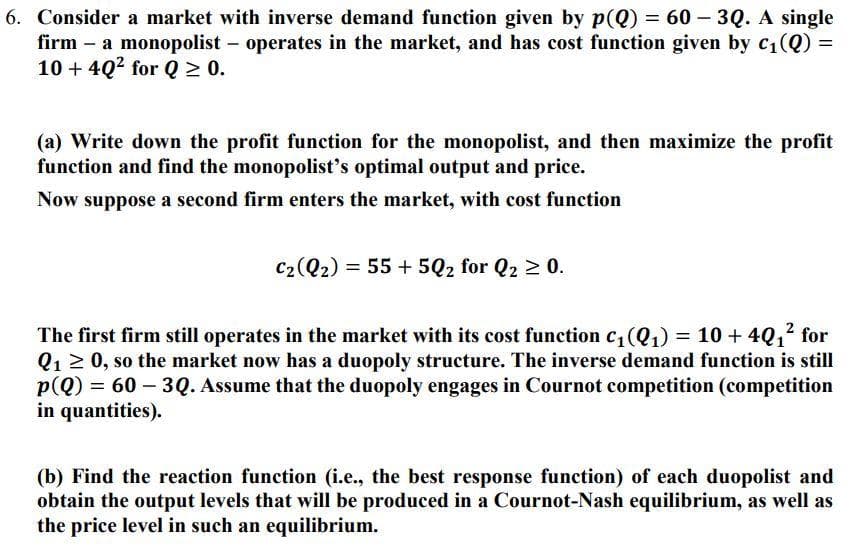Consider a market with inverse demand function given by p(Q) = 60 - 3Q. A single firm - a monopolist - operates in the market, and has cost function given by c₁(Q) = 10+ 40² for Q≥ 0. (a) Write down the profit function for the monopolist, and then maximize the profit function and find the monopolist's optimal output and price. Now suppose a second firm enters the market, with cost function C₂ (Q2) = 55+5Q2 for Q₂ ≥ 0. The first firm still operates in the market with its cost function c₁(Q₁) = 10 + 40₁² for Q₁ ≥ 0, so the market now has a duopoly structure. The inverse demand function is still p(Q) = 60-3Q. Assume that the duopoly engages in Cournot competition (competition in quantities). (b) Find the reaction function (i.e., the best response function) of each duopolist and obtain the output levels that will be produced in a Cournot-Nash equilibrium, as well as the price level in such an equilibrium.
Consider a market with inverse demand function given by p(Q) = 60 - 3Q. A single firm - a monopolist - operates in the market, and has cost function given by c₁(Q) = 10+ 40² for Q≥ 0. (a) Write down the profit function for the monopolist, and then maximize the profit function and find the monopolist's optimal output and price. Now suppose a second firm enters the market, with cost function C₂ (Q2) = 55+5Q2 for Q₂ ≥ 0. The first firm still operates in the market with its cost function c₁(Q₁) = 10 + 40₁² for Q₁ ≥ 0, so the market now has a duopoly structure. The inverse demand function is still p(Q) = 60-3Q. Assume that the duopoly engages in Cournot competition (competition in quantities). (b) Find the reaction function (i.e., the best response function) of each duopolist and obtain the output levels that will be produced in a Cournot-Nash equilibrium, as well as the price level in such an equilibrium.
Chapter14: Monopoly
Section: Chapter Questions
Problem 14.5P
Related questions
Question
4

Transcribed Image Text:6. Consider a market with inverse demand function given by p(Q) = 60 - 3Q. A single
firm - a monopolist - operates in the market, and has cost function given by C₁(Q) =
10+ 40² for Q≥ 0.
(a) Write down the profit function for the monopolist, and then maximize the profit
function and find the monopolist's optimal output and price.
Now suppose a second firm enters the market, with cost function
C₂ (Q₂) = 55+5Q2 for Q₂ ≥ 0.
The first firm still operates in the market with its cost function c₁ (Q₁) = 10 + 40₁² for
Q₁ ≥ 0, so the market now has a duopoly structure. The inverse demand function is still
p(Q) = 60-3Q. Assume that the duopoly engages in Cournot competition (competition
in quantities).
(b) Find the reaction function (i.e., the best response function) of each duopolist and
obtain the output levels that will be produced in a Cournot-Nash equilibrium, as well as
the price level in such an equilibrium.
Expert Solution
This question has been solved!
Explore an expertly crafted, step-by-step solution for a thorough understanding of key concepts.
Step by step
Solved in 6 steps

Knowledge Booster
Learn more about
Need a deep-dive on the concept behind this application? Look no further. Learn more about this topic, economics and related others by exploring similar questions and additional content below.Recommended textbooks for you








Managerial Economics: Applications, Strategies an…
Economics
ISBN:
9781305506381
Author:
James R. McGuigan, R. Charles Moyer, Frederick H.deB. Harris
Publisher:
Cengage Learning
